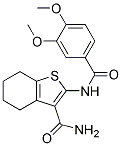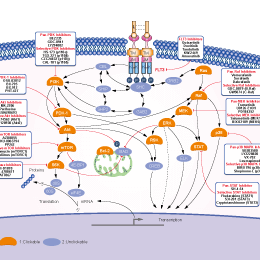
- Bioactive Compounds
- By Signaling Pathways
- PI3K/Akt/mTOR
- Epigenetics
- Methylation
- Immunology & Inflammation
- Protein Tyrosine Kinase
- Angiogenesis
- Apoptosis
- Autophagy
- ER stress & UPR
- JAK/STAT
- MAPK
- Cytoskeletal Signaling
- Cell Cycle
- TGF-beta/Smad
- DNA Damage/DNA Repair
- Compound Libraries
- Popular Compound Libraries
- Customize Library
- Clinical and FDA-approved Related
- Bioactive Compound Libraries
- Inhibitor Related
- Natural Product Related
- Metabolism Related
- Cell Death Related
- By Signaling Pathway
- By Disease
- Anti-infection and Antiviral Related
- Neuronal and Immunology Related
- Fragment and Covalent Related
- FDA-approved Drug Library
- FDA-approved & Passed Phase I Drug Library
- Preclinical/Clinical Compound Library
- Bioactive Compound Library-I
- Bioactive Compound Library-Ⅱ
- Kinase Inhibitor Library
- Express-Pick Library
- Natural Product Library
- Human Endogenous Metabolite Compound Library
- Alkaloid Compound LibraryNew
- Angiogenesis Related compound Library
- Anti-Aging Compound Library
- Anti-alzheimer Disease Compound Library
- Antibiotics compound Library
- Anti-cancer Compound Library
- Anti-cancer Compound Library-Ⅱ
- Anti-cancer Metabolism Compound Library
- Anti-Cardiovascular Disease Compound Library
- Anti-diabetic Compound Library
- Anti-infection Compound Library
- Antioxidant Compound Library
- Anti-parasitic Compound Library
- Antiviral Compound Library
- Apoptosis Compound Library
- Autophagy Compound Library
- Calcium Channel Blocker LibraryNew
- Cambridge Cancer Compound Library
- Carbohydrate Metabolism Compound LibraryNew
- Cell Cycle compound library
- CNS-Penetrant Compound Library
- Covalent Inhibitor Library
- Cytokine Inhibitor LibraryNew
- Cytoskeletal Signaling Pathway Compound Library
- DNA Damage/DNA Repair compound Library
- Drug-like Compound Library
- Endoplasmic Reticulum Stress Compound Library
- Epigenetics Compound Library
- Exosome Secretion Related Compound LibraryNew
- FDA-approved Anticancer Drug LibraryNew
- Ferroptosis Compound Library
- Flavonoid Compound Library
- Fragment Library
- Glutamine Metabolism Compound Library
- Glycolysis Compound Library
- GPCR Compound Library
- Gut Microbial Metabolite Library
- HIF-1 Signaling Pathway Compound Library
- Highly Selective Inhibitor Library
- Histone modification compound library
- HTS Library for Drug Discovery
- Human Hormone Related Compound LibraryNew
- Human Transcription Factor Compound LibraryNew
- Immunology/Inflammation Compound Library
- Inhibitor Library
- Ion Channel Ligand Library
- JAK/STAT compound library
- Lipid Metabolism Compound LibraryNew
- Macrocyclic Compound Library
- MAPK Inhibitor Library
- Medicine Food Homology Compound Library
- Metabolism Compound Library
- Methylation Compound Library
- Mouse Metabolite Compound LibraryNew
- Natural Organic Compound Library
- Neuronal Signaling Compound Library
- NF-κB Signaling Compound Library
- Nucleoside Analogue Library
- Obesity Compound Library
- Oxidative Stress Compound LibraryNew
- Plant Extract Library
- Phenotypic Screening Library
- PI3K/Akt Inhibitor Library
- Protease Inhibitor Library
- Protein-protein Interaction Inhibitor Library
- Pyroptosis Compound Library
- Small Molecule Immuno-Oncology Compound Library
- Mitochondria-Targeted Compound LibraryNew
- Stem Cell Differentiation Compound LibraryNew
- Stem Cell Signaling Compound Library
- Natural Phenol Compound LibraryNew
- Natural Terpenoid Compound LibraryNew
- TGF-beta/Smad compound library
- Traditional Chinese Medicine Library
- Tyrosine Kinase Inhibitor Library
- Ubiquitination Compound Library
-
Cherry Picking
You can personalize your library with chemicals from within Selleck's inventory. Build the right library for your research endeavors by choosing from compounds in all of our available libraries.
Please contact us at [email protected] to customize your library.
You could select:
- Antibodies
- Bioreagents
- qPCR
- 2x SYBR Green qPCR Master Mix
- 2x SYBR Green qPCR Master Mix(Low ROX)
- 2x SYBR Green qPCR Master Mix(High ROX)
- Protein Assay
- Protein A/G Magnetic Beads for IP
- Anti-Flag magnetic beads
- Anti-Flag Affinity Gel
- Anti-Myc magnetic beads
- Anti-HA magnetic beads
- Magnetic Separator
- Poly DYKDDDDK Tag Peptide lyophilized powder
- Protease Inhibitor Cocktail
- Protease Inhibitor Cocktail (EDTA-Free, 100X in DMSO)
- Phosphatase Inhibitor Cocktail (2 Tubes, 100X)
- Cell Biology
- Cell Counting Kit-8 (CCK-8)
- Animal Experiment
- Mouse Direct PCR Kit (For Genotyping)
- New Products
- Contact Us
TCS 359
TCS 359 is a potent FLT3 inhibitor with IC50 of 42 nM.

TCS 359 Chemical Structure
CAS No. 301305-73-7
Purity & Quality Control
Batch:
S802301
DMSO]15 mg/mL]false]Water]Insoluble]false]Ethanol]Insoluble]false
Purity:
99.89%
99.89
TCS 359 Related Products
| Related Targets | FLT3-WT FLT3-ITD FLT3-D835Y | Click to Expand |
|---|---|---|
| Related Products | Dovitinib (TKI-258) Dovitinib (TKI258) Lactate monohydrate Tandutinib (MLN518) KW-2449 ENMD-2076 UNC2025 AST-487 (NVP-AST487) FF-10101 G-749 SKLB4771 (FLT3-IN-1) AMG 925 | Click to Expand |
| Related Compound Libraries | Tyrosine Kinase Inhibitor Library PI3K/Akt Inhibitor Library Angiogenesis Related compound Library HIF-1 Signaling Pathway Compound Library FDA-approved Anticancer Drug Library | Click to Expand |
Signaling Pathway
Biological Activity
| Description | TCS 359 is a potent FLT3 inhibitor with IC50 of 42 nM. | ||
|---|---|---|---|
| Features | Highly potent and selective. | ||
| Targets |
|
| In vitro | ||||
| In vitro | TCS 359, a 2-acylaminothiophene-3-carboxamide, is a potent inhibitor of FLT3 with IC50 of 42 nM. TCS 359 inhibits MV4-11 proliferation with IC50 of 340 nM. TCS 359 is highly selective for FLT3 against a panel of kinases. [1] | |||
|---|---|---|---|---|
| Kinase Assay | Affinity determination | |||
| To determine the activity of the compounds of the present invention in an in vitro kinase assay, inhibition of the isolated kinase domain of the human FLT3 receptor is performed using the following fluorescence polarization (FP) protocol. The FLT3 fluorescence polarization assay utilizes the fluorescein-labeled phosphopeptide and the anti-phosphotyrosine antibody included in the Panvera Phospho-Tyrosine Kinase Kit. The FLT3 kinase reaction is incubated at room temperature for 30 min under the following conditions: 10 nM FLT3 571-993, 20μg/mL poly Glu4Tyr, 150μM ATP, 5 mM MgCl2, and 1% compound in DMSO. The kinase reaction is stopped with the addition of EDTA. The fluorescein-labeled phosphopeptide and the anti-phosphotyrosine antibody are added and incubated for 30 min at room temperature and polarization is read. | ||||
| Cell Research | Cell lines | MV4-11 | ||
| Concentrations | ~5 μM | |||
| Incubation Time | 72 hours | |||
| Method | MV4-11 cells are plated at 10,000 cells per well in 100 μL of in RPMI media containing penn/strep, 10% FBS, and 0.2 ng/mL GM-CSF. Compound dilutions or 0.1% DMSO (vehicle control) is added to cells and the cells are allowed to grow for 72 h at standard cell growth conditions. To measure total cell growth, an equal volume of CellTiterGlo reagent is added to each well and luminescence is quantified. Total cell growth is quantified as the difference in luminescent counts of cell number at Day 0 compared to total cell number at Day 3 (72 h of growth and/or compound treatment). All IC50 values are calculated in GraphPadPrism using non-linear regression analysis with a multiparameter (variable slope) equation. | |||
Chemical Information & Solubility
| Molecular Weight | 360.43 | Formula | C18H20N2O4S |
| CAS No. | 301305-73-7 | SDF | Download TCS 359 SDF |
| Smiles | COC1=C(C=C(C=C1)C(=O)NC2=C(C3=C(S2)CCCC3)C(=O)N)OC | ||
| Storage (From the date of receipt) | |||
|
In vitro |
DMSO : 15 mg/mL ( (41.61 mM) Moisture-absorbing DMSO reduces solubility. Please use fresh DMSO.) Water : Insoluble Ethanol : Insoluble |
Molecular Weight Calculator |
|
In vivo Add solvents to the product individually and in order. |
In vivo Formulation Calculator |
||||
Preparing Stock Solutions
Molarity Calculator
In vivo Formulation Calculator (Clear solution)
Step 1: Enter information below (Recommended: An additional animal making an allowance for loss during the experiment)
mg/kg
g
μL
Step 2: Enter the in vivo formulation (This is only the calculator, not formulation. Please contact us first if there is no in vivo formulation at the solubility Section.)
% DMSO
%
% Tween 80
% ddH2O
%DMSO
%
Calculation results:
Working concentration: mg/ml;
Method for preparing DMSO master liquid: mg drug pre-dissolved in μL DMSO ( Master liquid concentration mg/mL, Please contact us first if the concentration exceeds the DMSO solubility of the batch of drug. )
Method for preparing in vivo formulation: Take μL DMSO master liquid, next addμL PEG300, mix and clarify, next addμL Tween 80, mix and clarify, next add μL ddH2O, mix and clarify.
Method for preparing in vivo formulation: Take μL DMSO master liquid, next add μL Corn oil, mix and clarify.
Note: 1. Please make sure the liquid is clear before adding the next solvent.
2. Be sure to add the solvent(s) in order. You must ensure that the solution obtained, in the previous addition, is a clear solution before proceeding to add the next solvent. Physical methods such
as vortex, ultrasound or hot water bath can be used to aid dissolving.
Tech Support
Answers to questions you may have can be found in the inhibitor handling instructions. Topics include how to prepare stock solutions, how to store inhibitors, and issues that need special attention for cell-based assays and animal experiments.
Tel: +1-832-582-8158 Ext:3
If you have any other enquiries, please leave a message.
* Indicates a Required Field
Tags: buy TCS 359 | TCS 359 supplier | purchase TCS 359 | TCS 359 cost | TCS 359 manufacturer | order TCS 359 | TCS 359 distributor







































